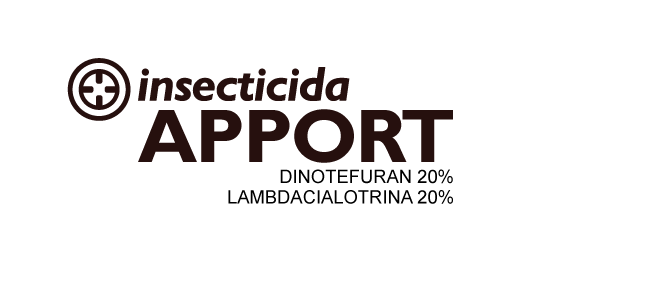
Composition:
| Dinotefuran: (EZ)-(RS)-1-methy1-2-nitro-3-(tetrahydro-3-furylmethyl)guanidine | 20 % (p/v) |
| Lambdacialotrina: mezcla de isomeros (S)-a-cyano-3-phenoxybenzyl(Z)-(1 R,3R)-3-(2-chloro-3,3, 3-trifluoroprop-1-enyl)-2,2-dimethylcyclopropanecarboxylate and (R)-a-cyano-3-phenoxybenzyl (Z) -2-(1 S,3S)-3-(2-chloro-3,3,3-trifluoroprop-1-enyl)-2,2-dimethylcyclopropanecarboxylate | 20 % (p/v) |
| Inert | 60 % (p/v) |
Chemical group:
NEONICOTINOID + PYRETHROID.
Formulation:
EMULSIFIABLE CONCENTRATE (EC).
Generalidades:
APPORT is a broad spectrum and residual action insecticide, with systemic and translaminar activity, protecting the crip in an integral way. Is an insecticide that presents quick knock down effect and prolonged persistence effect in the control, composed of the combination of two active ingredients.
Application method:
The application can be via air or land.
– Add water to the sprayer tank up to half its capacity.
– Start the stirring system.
– Add the necessary amount of the formulation, according to the calibration carried out, directly into the tank and without prior dissolution.
– Check the correct dilution of the product.
– Fill the tank with water up to the final volume.
– Check that the agitation system works at all times.
– Use the product within 24 hours after the carrying out the mixture in the tank.
– Re-agitate the liquid before resuming the application.
– Always use clean water.
Phytotoxicity and compatibility:
Avoid the mixture with alkaline products. Before using it mixed with other products, a small-scale test should be carried out, to evaluate the physical and biological compatibility of the components and the possible phytotoxicity for crops.
Re-entry time to the area of treatment:
1 day. If the re-entry is necessary, do it by employing personal protective equipment.
Toxicological class:
Class II – Yellow Stripe.
Antidote:
Does not possess.
Packing:
1- Container of 5 Lts.
Direction for use:
Diseases:
– Small Rice Stinkbug / Oebalus poecilus
– Rice stalk Stinkbug / Tibraca limbativentris
Dose (ml/ha): 200 – 300
Time of Application: Use 200 cc/ha when the first stinkbugs are observed (no more than 1 at the time of flowering when passing the net) and 300 cc/ha, when there’s higher plague pressure (more than 2 individuals in flowering, or more than 0,5 individuals in the milky grain stage).
WP (days): n/e
MRL (mg/kg): n/e
Diseases:
– Brazilian owl / Caliothrips brasiliensis
– Green belly stinkbug / Dichelops furcatus
– Corn Leaf Aphid / Phopalosiphum maidis
Dose (ml/ha): Brazilian owl: 200-250
Green belly stinkbug: 250-350
Corn Leaf Aphid: 200-250
Time of Application:
Brazilian owl: When the first nymphs are observed per leaf blade.
Green belly stinkbug: The control must begin when the first outbreaks of plague emergence are observed.
Corn Leaf Aphid: When the first outbreaks of aphid attacks are observed.
WP (days): n/e
MRL (mg/kg): n/e
Diseases:
– Whitefly / Bemisia tabaci
– Brown stink bug / Euschistus heros
– Green stink bug / Nezara viridula
– Redbanded stink bug / Piezodorus guildinii
– Green and Brown stink bug / Edesa meditabunda
– Green-belly stink bug / Dichelops spp.
– Brazilian owl / Caliothrips brasiliensis
Dose (ml/ha): Whitefly: 200 – 350 –
Brown stink bug, Green stink bug, Redbanded stink bug and Green and Brown stink bug: 200-250
Brazilian owl: 200
Time of Application: Whitefly: applications must start when the first whitefly adults are observed in the lot and perform the active ingredients rotation to avoid the emergence of resistance. Brown stink bug, Green stink bug, Redbanded stink bug and Green and Brown stink bug: use the dose of 200 when the first stink bugs are observed, no more than 1 stinkbug per cloth since flowering until R2 and the dose of 250 when there’s higher plague pressure (more than 2 individuals in flowering, or more than 0,5 individuals from R3 to R6). Brazilian owl: when there are 5 nymphs per leaflet.
WP (days): n/e
MRL (mg/kg): n/e
Diseases:
– Grain Aphid / Rhopalosiphurm padi
Dose (ml/ha): 100-200
Time of Application: Perform the application when observed 10% of the plants attacked by the aphid in vegetative stage and 10 aphids per ear for the heading stage until bulk grain.
WP (days): n/e
MRL (mg/kg): n/e
WP: Waiting Period
MRL: Maximum Residue Limit
n/e: not established
Downloads
967 KB


